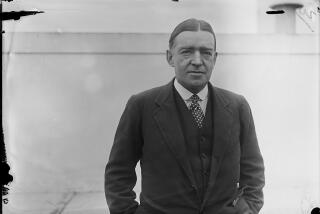Scientists Elated by ‘Spectacular’ Pictures : Titanic in Pieces, Search Team Reports
- Share via
WOODS HOLE, Mass. — The U.S. and French scientists who discovered the sunken luxury liner Titanic headed for home port here early Thursday, exhausted and elated after an all-night underwater photography probe found that the supposedly “unsinkable” ship had apparently broken apart on the Atlantic Ocean floor.
“Initially, they said it was intact,” said Nancy Green, a spokeswoman at the Woods Hole Oceanographic Institution, which announced the find this week. “Now, they’re finding there was much more damage than they thought. One thing they’re not seeing is the stern of the ship.”
Shelley Lauzon, information director for the nonprofit marine research institution, said Thursday morning that the scientists had worked all night and had produced “spectacular” undersea color video pictures and more than 12,000 color and black and white photographs of the ship’s bow and nearby debris. She said that the photos include details of dishes, luggage, chamber pots, plumbing, coal and five cases of wine “in perfect condition” on the ocean floor.
Smokestack Missing
Lauzon said that the 47 scientists and crew members aboard the research vessel Knorr held a special memorial service Sunday on the fantail of their ship for the 1,513 victims of the famed maritime disaster. The Titanic, the largest and most luxurious liner of its time, struck an iceberg and sank on its maiden transatlantic voyage on April 14, 1912.
Some survivors later said that the 882-foot-long, 45,000-ton ship appeared to break in two when boilers exploded as it sank. Dr. Robert D. Ballard, chief scientist aboard the Knorr, previously had said that the first of four distinctive raked, yellow and black smokestacks was missing and that the exploding boilers had blown a gaping hole in the ship’s side.
On Thursday, Knorr confirmed that the Titanic appeared to have split in two and that the stern had not been found. In a ship-to-shore telephone interview with ABC’s “Good Morning America,” Ballard warned against attempts to salvage the 73-year-old wreck, which rests upright near a deep trench on a boulder-strewn field about 13,000 feet under water.
“They’d have to salvage it in several places,” Ballard said. “It’s not intact. I don’t see the point of it. I can’t believe it has any commercial value. It seems such a bad thing to do. It’s a grave site and memorial for 1,500 souls.”
Lauzon said the Knorr left the search site, about 370 miles southeast of Nova Scotia and 500 miles south of Newfoundland, early Thursday morning. She said the Knorr is expected to return to this scenic Cape Cod port by 1 p.m. Monday.
The U.S. Navy owns the Knorr, and is chief financial backer for the current tests of a special unmanned underwater TV and sonar probe. Institution officials emphasized that the scientists had gone to the suspected site of the Titanic to test the new system for ocean mapping and exploration.
The expedition’s success was no accident, however. A two-foot-long, hand-painted scale model of the Titanic dominates Ballard’s conference table here. And the 43-year-old oceanographic geologist has studied the sinking for years, reading every book and report on the ship, according to longtime friend and colleague Skip Marquet. “Bob is a dreamer,” Marquet said.
More to Read
Sign up for Essential California
The most important California stories and recommendations in your inbox every morning.
You may occasionally receive promotional content from the Los Angeles Times.










